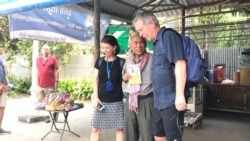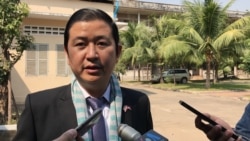Khmer Rouge victims from the S-21 prison in Phnom Penh said last week they were appreciative of efforts to restore and preserve textiles and clothing belonging to victims detained at the notorious site.
Chum Mey, one of the few survivors from the former school-turned-prison, has made his life’s effort to come back to the Tuol Sleng prison on most days to remind and educate people of the atrocities committed there.
Attending an event last week, where the United States Embassy funded a $75,000 project to restore the textiles, Chum Mey said he supported the “important” project because it was in line with his intentions – to preserve artifacts and stories about the Khmer Rouge for educational purposes.
“How important is it?” he queried. “It is important for the next generations to know the truth. If we don’t preserve all these things, they will disappear.”
The launch of the project was attended by Culture Minister Phoeurng Sackona and U.S. Ambassador W. Patrick Murphy last Thursday. The U.S. ambassador said it was critical to preserve the “sacred objects”, which were visual reminders of the genocidal regime.
“They help educate us all now and in the future. Future generations who will definitely need that kind of education to know exactly what took place, and how we can ensure it doesn’t happen again,” Murphy said.
Minister Sackona and Murphy were then taken on a short tour of the existing textiles, which include clothing and hats, and were informed of the stories behind some of the preserved piece.
Accompanying them, Chhay Visoth, director of the Tuol Sleng Genocide Museum, said that apart from being a reminder for all people of the Khmer Rouge’s violent regime, the restoration project will be helpful for researchers and historians.
He said the information gathered and published from the restoration project can be used by academics, who now had little chance to view or study the textiles because of their delicate condition.
“This is huge because we can’t put all these clothes on display,” he said. “We can’t do that because we are concerned, not about theft, but the clothes being damaged due to moisture and the [hot] weather.”
During the first phase, the project involved an American preservation expert, Julia Brennan, who helped train the museum staff with techniques to preserve the nearly 5,000 pieces of clothing. U.S. Embassy officials said the first two phases of the project had cost $130,000.
Minister Sackona said that there were hats with names of prisoners on them, making them valuable objects to document the stories of people who were detained at the prison.
“Besides this, there is history such some hats were written with names. So, it’s necessary to show the [backgrounds of] individuals and the history of our country, and the sufferings that took place in this Tuol Sleng prison,” she added.
Intimately aware of the benefits of documenting the Khmer Rouge years, Youk Chhang, the executive director of DC-CAM, said that even small amounts of money could make large impacts when it came to preservation of Khmer Rouge era items.
“This funding is small because small steps are sometimes more impactful than large leaps,” he added.
As he continues to visit the museum frequently, Chum Mey, who also sells a book about his experiences, said he wanted the U.S. to increase their funding, fearing that vestiges of the genocidal regime could disappear at some point.
“We want them to continue adding funding further because we have to organize and preserve what happened from disappearing,” he added.


